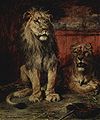Paul Friedrich Meyerheim
Paul Friedrich Meyerheim (born July 13, 1842 in Berlin ; † September 14, 1915 there ) was a German painter and graphic artist .
At the beginning of his artistic career, Paul Meyerheim went several times to Paris and Barbizon to perfect himself in landscape painting . His special talent lay in depicting animals. He has also made a name for himself as a portraitist and was successful as an illustrator with his woodcuts and lithographs .

family
Meyerheim was the son of the painter Friedrich Eduard Meyerheim ; his older brother was the painter Franz Meyerheim . The painters Hermann and Wilhelm Meyerheim were his paternal uncles.
Life
Meyerheim received his first artistic lessons (together with his brother) from his father. From 1857 to 1860 Meyerheim attended the art academy in his hometown. There he also visited the studio of the animal painter Teutwart Schmitson , whose painting strongly influenced him. Later he made several study trips to Switzerland, Belgium and Holland and stayed in Paris for a year. He then returned to Berlin, where he was head of the animal painting class at the Berlin Art Academy as early as 1883. From 1887 Meyerheim was a professor at the Art Academy, where he trained Fritz Grotemeyer , and later became a member of the Senate .
Paul Meyerheim was friends with the industrialists Borsig family, which is why he drew some special motifs for the family and the Borsig company . He belonged to the group of well-known artists who were regularly invited by the Crown Prince couple (later Emperor Friedrich III ).
He died eight weeks after his 73rd birthday. His grave (under a stele-shaped tomb) in the Friedrichsfelde central cemetery is still preserved today.
plant
Initially Meyerheim's style was influenced by the meticulous depictions of his father. Later his friend Adolph Menzel served as a role model, with whom he shared a common interest in animal and zoo motifs. The virtuoso representation of exotic animals became his, albeit not exclusive, specialty. For example, with the wall paintings in the vestibule of the antelope house in Berlin's zoological garden, he helped to show animals from foreign countries in their natural environment. His animal shack pictures, on the other hand, show the frightening situation of a tightly packed mess of exotic animals and gazing onlookers. Meyerheim's skills in the field of landscape painting can only be seen in paintings such as “The Goat Trader in the Village”, which he had done twenty years earlier. Portraits and pictures from popular life continued to be an integral part of his work. The latter ranges from simple still lifes to humorous scenes, with which he decorated various banquet and dining rooms.
A sensation at the Great Berlin Art Exhibition of 1912 were seven huge pictures that Paul Meyerheim had painted on copper between 1873 and 1876 on behalf of Albert Borsig . The cycle was called the Life Story of a Locomotive and was originally intended for the garden loggia on Borsig's private property in Alt-Moabit . Anecdotal scenes from the Borsig production facilities, assembly and loading of a locomotive, and the description of a harvest festival at the Borsig family linked the important industrial plant with the Borsig family history. At the same time this work was an important contribution of Berlin painting to the early industrial representation. Some panels are now in the possession of the Märkisches Museum in Berlin-Mitte and the German Museum of Technology .
Other paintings by the painter:
- Amsterdam Antiquarian (1869)
- Villa Borsig (1855, National Gallery Berlin )
- Animal shack (1885, National Gallery Berlin)
- The four seasons in the life of birds
- Cycle of 4 pictures in casein painting
- Little Red Riding Hood
- Cinderella (1870)
- Sheep Shearing (1872)
- The Wildenbude (1874)
- Coal Pile in the Bavarian Mountains (1878)
- Friedrich Eduard Meyerheim (portrait)
- Daniel Chodowiecki (1887, portrait)
Locomotive construction from the cycle life story of a locomotive , 1873–1876
student
Among the important students of Meyerheim are u. a. the animal trainer August Gaul (1869–1921) and the sculptor and animal trainer Friedrich Franz Brockmüller (1880–1958). Another student was the painter and draftsman Paul Freytag (1873–1954).
literature
- Staatliche Museen Berlin: Art in Berlin 1648–1987 . Henschelverlag, Berlin 1987, p. 298.
- Hans Joachim Neidhardt: German painting of the 19th century . EA Seemann Verlag, Leipzig 1990, ISBN 3-363-00468-0 , p. 176 u. 258.
- Irmgard Wirth: Berlin painting in the 19th century . Siedler Verlag, Berlin 1990, ISBN 3-572-10011-9 , p. 418.
Web links
- Literature by and about Paul Friedrich Meyerheim in the catalog of the German National Library
Individual evidence
- ^ Westfälische Nachrichten : Fritz Grotemeyer , Münster, July 28, 2016
| personal data | |
|---|---|
| SURNAME | Meyerheim, Paul Friedrich |
| ALTERNATIVE NAMES | Meyerheim, Paul Friedrich (full name) |
| BRIEF DESCRIPTION | German painter and graphic artist |
| DATE OF BIRTH | July 13, 1842 |
| PLACE OF BIRTH | Berlin |
| DATE OF DEATH | September 14, 1915 |
| Place of death | Berlin |










